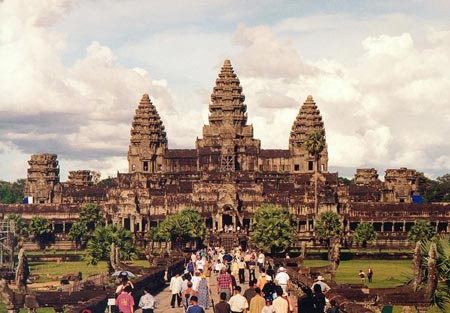How did the Khmer Empire perish?
Climate change may be the indirect cause of the collapse of the Khmer kingdom in Cambodia nearly 600 years ago.

The temple of Angkor Wat is one of the legacies of the Khmer empire.Photo: wikipedia.org.
The Khmer Empire stretched over most of Southeast Asia from 801 to 1400 before abruptly disappearing. Livescience affirmed that this is one of the greatest civilizations in human history before it died. For decades, historians have made numerous explanations of the extinction of the Khmer empire. Some experts argue that the cause is conflict with other countries, while many insist that the empire is destroyed due to degraded land.
But, according to Livescience, Brendan Buckley - a climate expert at Columbia University, the United States has found credible evidence that the Khmer empire was depleted due to lack of water for agricultural production and daily life. That situation caused paralysis of Angkor's large-scale irrigation system, which was very important to the agricultural economy. The culprit causing water scarcity are two severe droughts caused by climate change.
Buckley and his colleagues rebuilt the climate picture in the area around the ancient Khmer capital of the Khmer empire by studying the circles inside the cypress trees in a nearby national park. Circles show that the kingdom experienced a super drought that lasted for three decades - from about 1330 to 1360. After that the kingdom suffered a more severe but shorter drought in Buckley said that the two periods of super drought could make crops fail and infectious diseases spread - two disasters for a country with a large population density. Then in 1431, the kingdom collapsed after an attack by Siam (Thailand today).
'At that time Angkor's capital faced a series of social, political and cultural problems. The big change in the environment has pushed Khmer people to the final limit in tolerance and they cannot adapt to that change. I am not saying climate change is the direct cause of the collapse of the ancient Khmer civilization, but it is certain that a 30-year drought must have some impact , 'Buckley said.
Buckley's group also found evidence of strong rainy seasons that destroyed Angkor's capital system. During the normal rainy season, huge irrigation systems - including canals, dykes, water reservoirs - of Angkor can withstand heavy rainfall. But after a prolonged super drought, the system could be destroyed.
Experts believe that El Niño, created by the warming of warm water in the eastern Pacific Ocean, causes a huge amount of steam to enter the air, also playing an important role in preventing the rainy season. in the area around Angkor, prolonged drought.
'We need to remember that civilizations are still vulnerable to climate change,' said Kevin Anchukaitis, a member of the research team.
Many previous studies have shown that sudden changes in the environment can push ancient civilizations to perdition. The civilization of the Anasazi people in the southwest of the United States, the Mayan empire in Central America and the Akkadian kingdom of Mesopotamia (present-day south-west Asia) are civilizations disappearing due to climate change.
- The real reason why the ancient Khmer Empire was forced to move the capital, only to make a historical legend
- Legend of the greatest king of the Khmer empire
- Discover the mysterious old city in the jungle of Cambodia
- Discover the world's largest empire in Cambodia
- The most powerful Empire ever defeated the Roman Empire and ended after 'bullying' Russia
- Learn 4 Iraq's mighty empire
- Fraternity is similar to the collapse of the Inca empire
- Khleang - Khmer temple
- Discovered the unexpected cause of the collapse of the ancient Roman empire
- Horrifying revelations about the Eastern Roman Empire
- Decode extreme military tactics of the Ottoman Empire
- Behind the fall of the Maya empire
 Discovered an ancient centipede fossil 99 million years old
Discovered an ancient centipede fossil 99 million years old Discovered bat-like dinosaurs in China
Discovered bat-like dinosaurs in China Discovered a 200-year-old bronze cannon of the coast
Discovered a 200-year-old bronze cannon of the coast Discover 305 million-year-old spider fossils
Discover 305 million-year-old spider fossils